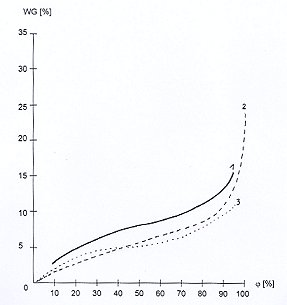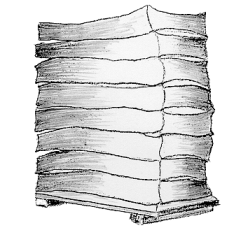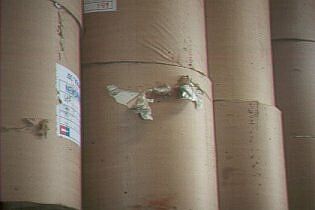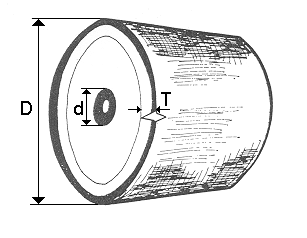Paper is a flat material made essentially from fibers of predominantly vegetable origin by dewatering a fiber pulp (fiber suspension) to produce a fiber felt which is then compressed and dried. The most important fibrous raw materials are wood and waste paper. The following are types of paper:
- Printing and publication paper
- Office paper and stationery
- Paper, cardboard and paperboard for packaging purposes
- Sanitary paper
- Paper and paperboard for industrial and special purposes
Due to their processing, they belong to the class of goods in which respiration processes are suspended, but in which biochemical, microbial and other decomposition processes still proceed; they thus exhibit 3rd order biotic activity (BA 3). Paper and paper products require particular temperature, humidity/moisture and possibly ventilation conditions (SC VI).
Where paper is transported in containers, it is mostly standard containers that are used.
Transport instructions and damage
Packaging
Newsprint, paperboard, corrugated board and other types of paper are generally transported in rolls up to 300 cm wide and with a total weight of up to 4.5 metric tons. The circumferential packaging for the paper rolls wound ultratightly onto paperboard cores is up to 3.5 mm thick and, as a rule, consists of several plies of kraft paper. The circumferential packaging is folded over at the ends. The ends of the rolls are protected by paperboard covers. In many cases, the final kraft paper cover is plastic-coated and stuck to the folded-over circumferential packaging. It protects the roll if loaded vertically.
- Filter paper, waste paper and the like are predominantly transported in bales strapped with wire.
- Photographic paper, waxed paper and the like are transported in solid wooden cases.
- Sheet paper is wrapped in packing paper and the packages are strapped to pallets with steel strapping.
Hygroscopicity
As paper is mainly made from vegetable fibers, it is hygroscopic and has a tendency to swell. Improper storage may result in dimensional changes, distortion and reduced strength.
 |
Figure 181: Sorption isotherms for various types of paper 1 - glassine paper (20°C) 2 - paper (20°) 3 - filter paper |
The water content of paper amounts to 6 - 10%, depending on the type; this value stays constant at the storage climate of 20°C + 5°C most favorable for these materials and a relative humidity of 65% + 5%. Fig. 181 shows examples of sorption isotherms for various types of paper.
| Type | Water content in % | Rel. humidity in % | |
| 1. | Waste paper | 6 - 12 |
65 - 70 |
| 2. | Filter paper | 5 - 8 |
65 - 70 |
| 3. | Cardboard: | ||
| Chromo imitation board | 5 - 8 |
65 - 70 |
|
| Chromo board | 6 - 9 |
65 - 70 |
|
| Folding carton board | 9 - 12 |
65 - 70 |
|
| Cup board | 6 - 8 |
60 - 70 |
|
| 4. | Packing paper | 5 - 9 |
65 - 70 |
| 5. | Paper bales | 6 - 10 |
65 - 70 |
| 6. | Millboard | 8 - 10 |
65 - 70 |
| 7. | Waxed paper | 5 - 9 |
65 - 70 |
| 8. | Corrugated board | 8 - 14 |
65 - 70 |
| 9. | Newsprint | 6 - 10 |
60 - 70 |
Table 32:
Water contents and equilibrium moisture contents for paper and paper products
During cargo handling, paper and paper products must be protected from all forms of moisture, as there is a risk of losses caused by swelling and tearing of individual layers. To protect paper from dripping sweat in the container, a nonwoven fabric should be attached beneath the container roof.
Condensation water is particularly likely to occur during voyages from cold to hot climates (Scandinavian ports, Continental ports - tropical unloading ports in Africa, Asia) or during unloading of the paper in tropical ports if the goods could not be sufficiently warmed up during the voyage and were exposed to the hot ambient air upon opening of the container doors. Condensation ("cargo sweat") occurs on the goods (see Section 10.3.5). One loss prevention measure which could be taken in such an instance would be to leave the containers standing for two to three days in the warm environment, until the rolls of paper have adapted to the ambient temperature. This "warming up" of the cargo, until its temperature is higher than the dew point of the ambient air at the receiving point, may be shortened or omitted if the container has been transported on deck and has thus been able to adapt to the air temperature at the port of discharge. Unfortunately, little or no influence is to be had over container stowage positions on the ship, despite the latest developments in data processing.
Wetting damage may also arise as a result of wet set-down surfaces during storage. The container floor must not be too damp. A maximum water content of 15% should not be exceeded. Swelling caused by wetting may lead to a 50-70% increase in volume, resulting in swelling and bursting of the outer layers to a considerable depth and rendering several hundred layers of paper unusable.
Moisture- or wetness-damaged paperboard, paper, filter paper and cardboard goods suffer quality degradation. This is revealed externally by distortion, torsion, changes in smoothness and color, reduction in mechanical tensile strength and waviness.
If the water content of paperboard falls to < 8% and that of cardboard goods to < 5%, brittleness and shrinkage of the fibers occur. Since stacked sheets cannot enter into a free exchange of moisture with the ambient air, this equalization is limited to the edges in contact with the air. This causes bulging of the edge areas and buckling of the board, which is promoted in particular by intense solar radiation (see Fig. 182).
 |
Figure 182: Buckling of paper on a pallet |
Temperature and fire hazard
The favorable travel temperature range is 0 - 25°C. Care must be taken if paper packages on pallets are exposed to the sun: they lose moisture and the resultant drying-out causes the outsides to shrink, leading to bulging and bending (buckling).
Paper, paperboard and waste paper in stacked bales tend towards heat-induced spontaneous combustion. The autoignition temperature is 100°C. The cargo must be protected from sparks and smoking must be prohibited during the packing and unpacking of containers.
Roofing felt, which is impregnated with bituminous impregnating agents (tar, asphaltic bitumen) can be ignited by a match flame. When stacked, fresh roofing felt has a tendency to heat-induced spontaneous combustion.
Mechanical damage
Mechanical damage arises as a result of pressure, impact, friction (chafing) and unsuitable handling equipment. Only special cargo handling gear, such as clamp lift trucks and rotating clamp lift trucks, should be used for handling rolls of paper.
Mechanical damage may arise when transporting palletized goods, especially during packing and unpacking of the container using forklift trucks. If, for example, excessively long forks are used on the forklift trucks which project on the other side of the pallet, other items of cargo may be damaged if the pallet is loaded closely up against them. Incorrect cargo securing creates the greatest risk of damage. On the one hand, the cargo may be damaged by the cargo securing itself, and on the other hand inadequate cargo securing provides considerable scope for damage. Cargo securing should always be absolutely tight.
- Indentations
Indentations cause damage as far as they extend into the paper layers. It is therefore essential that no cargo residues or residual material from previous cargo securing remain in the container and that there are no unevennesses.
- Edge and tear damage
Edge and tear damage arise as a result of shocks and impacts. Although the damage may often look slight on the outside, once the packaging is removed paper loss often proves considerable, as the snagged layers are unsuitable for processing. Snagging makes the layers unusable over the depth of the snags; they are torn off (stripped down) and used only as waste paper (see Fig. 183).
 |
| Figure 183: Tear damage to paper rolls results in considerable paper losses, as the rolls become unusable to the depth of the snag. Photo: U. Schieder |
The percentage loss caused by snags to rolls can be determined according to the following formula (see Figs. 184, 185):
in which T = depth of snag D = diameter of roll d = diameter of core S = diameter loss in % |
Figure 184: Formula for determining percentage loss
in the case of snagged rolls [59]
| Figure 185: Diagram for calculating paper loss in the case of damaged rolls [59] T = depth of snag D = diameter of roll d = diameter of core |
 |
Table 33 provides an overview of the extent of losses suffered as a function of the depth of damage:
| Depth of damage | Roll diameter | ||
| 91 cm | 95 cm | 100 cm | |
| 3.0 cm | 12.91% | 12.37% | 11.76% |
| 4.0 cm | 17.02% | 16.31% | 15.52% |
| 5.0 cm | 21.02% | 20.17% | 19.19% |
| 6.0 cm | 24.94% | 23.93 | 22.79% |
| 7.0 cm | 28.75% | 27.61% | 26.30% |
| 8.0 cm | 32.47% | 31.19% | 29.74% |
| 9.0 cm | 36.08% | 34.69% | 33.09% |
| 10.0 cm | 39.60% | 38.10% | 36.36% |
Table 33: Outcome of damage as percentage of roll weight
with an assumed core diameter of 10 cm